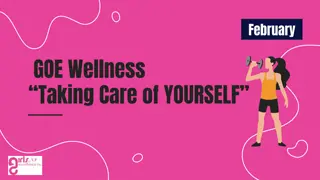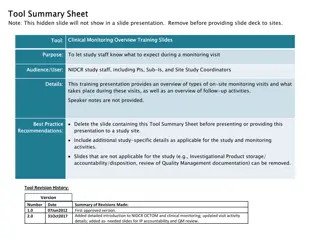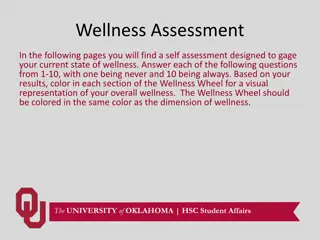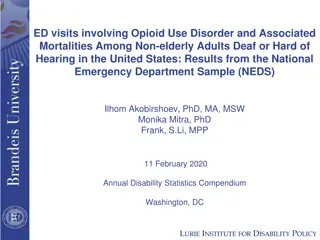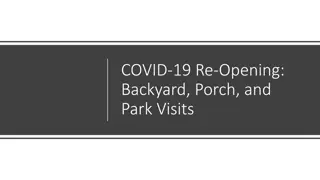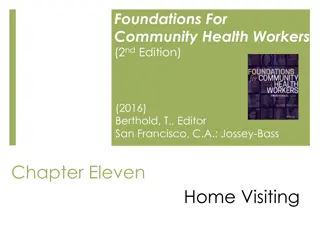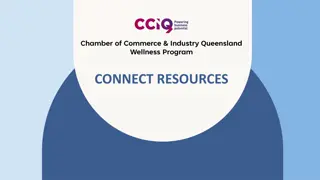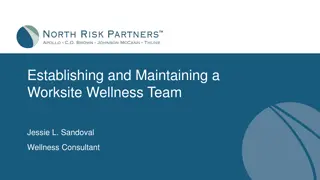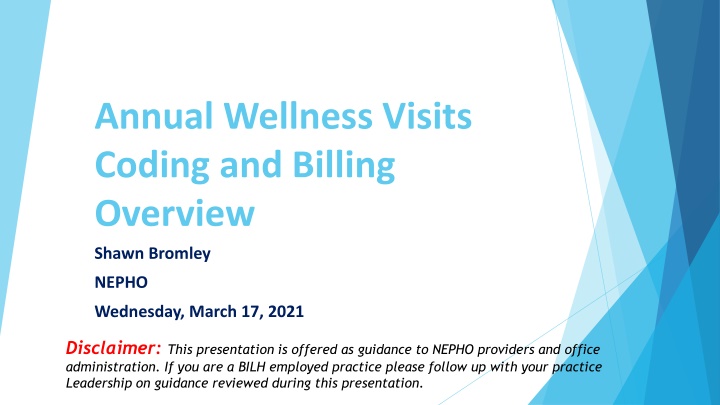
Annual Wellness Visits Coding and Billing Overview
Learn about the importance of Annual Wellness Visits (AWV), the components of AWV coding and billing, as well as the specific CPT codes used for reporting AWV services. Understand the goals of AWV, eligibility criteria, documentation requirements, and more to ensure proper coding and billing practices.
Download Presentation

Please find below an Image/Link to download the presentation.
The content on the website is provided AS IS for your information and personal use only. It may not be sold, licensed, or shared on other websites without obtaining consent from the author. If you encounter any issues during the download, it is possible that the publisher has removed the file from their server.
You are allowed to download the files provided on this website for personal or commercial use, subject to the condition that they are used lawfully. All files are the property of their respective owners.
The content on the website is provided AS IS for your information and personal use only. It may not be sold, licensed, or shared on other websites without obtaining consent from the author.
E N D
Presentation Transcript
Annual Wellness Visits Coding and Billing Overview Shawn Bromley NEPHO Wednesday, March 17, 2021 Disclaimer:This presentation is offered as guidance to NEPHO providers and office administration. If you are a BILH employed practice please follow up with your practice Leadership on guidance reviewed during this presentation.
Agenda Annual Wellness Visits (AWV) Overview Reason for the Visit Build Relationship with Provider Create a Plan of Care for Patient Coding Requirements and Components Health Care Professionals Who Can Bill AWV Face-to-Face Visits Telehealth Visits Documentation Examples Billing Evaluation and Management (E/M) during AWV Chronic Condition Capture During AWV
AWV Overview The AWV is a conversation between patient and provider to discuss the patients health history and any concerns they have regarding your health. It is a visit to review medications and immunizations. It also a good time when patient and provider review existing health problems; determine what health issues may become a concern in the future and how to prevent them. The goals of an AWV is to create a complete personal and family health history and to help prevent future health problems. The AWV is a non-touch visit. The AWV gives the patient and their provider a complete picture of the patients health and what they need to do to stay healthy. This is a visit to help the patient understand their current health status and steps they need to take to ensure their health stays healthy throughout the year. The AWV is an opportunity to really coordinate care. It is a time to talk proactively about the whole patient, especially their medical and family history and current health conditions, along with medications and supplements. The provider can also obtain specific vitals, such as height, weight, body mass index, blood pressure and vision, and discuss recommended screenings and vaccinations.
Coding and Billing AWV The two CPT codes used to report AWV services are: G0438 initial visit G0439 subsequent visit G0438: Billable for the first AWV only. Patient is eligible after the first 12 months of Medicare coverage. For services within the first 12 months, conduct the Initial Preventive Physical Exam (IPPE), also referred to as the Welcome to Medicare Visit (G0402). G0439: Billable for subsequent AWV. The patient cannot have had a prior AWV in the past 12 months.
Components of the G0438 Initial AWV The patient must not have received an IPPE (G0402) within the past 12 months. Administer a Health Risk Assessment (HRA) that includes, at a minimum: demographic data, self- assessment of health status, psychosocial and behavioral risks, and activities of daily living (ADLs), instrumental ADLs including but not limited to shopping, housekeeping, managing own medications, and handling finances. Establish the patient s medical and family history. Establish a list of current physicians and providers that are regularly involved in the medical care of the patient. Obtain blood pressure, height, weight, body mass index or waist circumference, and other measurements, as deemed appropriate. Assess patient s cognitive function. Review risk factors for depression, including current or past experiences with depression or mood disorders. Review patient s functional ability and safety based on direct observation, or the use of appropriate screening questions. Establish a written screening schedule for the individual, such as a checklist for the next 5 to 10 years based on appropriate recommendations. Establish a list of risk factors and conditions for primary, secondary, or tertiary intervention. Provide personalized health advice to the patient, as appropriate, including referrals to health education or preventive counseling services and programs.
Components of the G0439 Subsequent AWV The patient cannot have had a prior AWV in the past 12 months. Update the HRA. Update the patient s medical and family history. Update the current physicians and providers that are regularly involved in providing the medical care to the patient, as developed during the initial AWV. Obtain blood pressure, weight (or waist circumference, if appropriate), and other measurements, as deemed appropriate. Assess patient s cognitive function. Update the written screening schedule checklist established in the initial AWV. Update the list of risk factors and conditions for which primary, secondary, and tertiary interventions are recommended or underway. Provide personalized health advice to the patient, as appropriate, including referrals to health education or preventive counseling services and programs. At the patient's discretion, the subsequent AWV may also include advance care planning services.
Healthcare Professional Who Can Bill AWV Physician Physician assistant (PA) Nurse practitioner (NP) Clinical nurse specialist (CNS) Medical professional (including a health educator, registered dietician or nutrition professional, or other licensed practitioner) or a team of medical professionals working under the direct supervision of a physician.) Non-physicians must legally be authorized and qualified to provide AWVs in the state in which the services are furnished.
Face-to-Face Visits Versus Telehealth AWV Providers and patients who use telehealth are not always required to have a previously established relationship. Medicare will pay equally for telehealth and face-to-face visits. Providers often experience the increased demands of offering more services, while abiding by more policies and regulations. There is always a need to make the numbers work at a reimbursement level. Financial sustainability is the only way providers can maintain operations. AWV provide revenue while helping to build the provider and patient relationship that support patient management of care. This build can be fostered through face-to-face and Telehealth visits. To help make the numbers work and sustain operations, providers are using population health models where skilled nurses lead a team-based approach to value-based patient care, which in turn creates more time for physicians. Virtual care and telehealth are becoming essential to maintaining a continuity of patient care in this evolving healthcare landscape.
Telehealth Audio/Video Visits Telehealth Supporting Audio/Video and Audio Only AWV: Telehealth allows the Provider and Practice Team to engage their patients. Telehealth helps identify and meet care needs before they become acute enough to require the patient to access an in-person healthcare setting. Telehealth will help assists in identifying and counseling on risky health behaviors during AWV. Telehealth AWV creates an opportunity for care teams to identify patients who would benefit from Chronic Care Management (CCM), which is especially important during periods of shelter- in-place orders. Requirements: The specific requirements included in the AWV essentially allows a practice to be reimbursed for reaching out to its patients to educate them about their health risks and the current crisis. CMS is also allowing the visit to be completed by clinical staff under physician supervision. It is a great way to use clinical staff who may otherwise be idle (or worse, furloughed) during the pandemic to grow a help grow a Telehealth program. All the normal service and documentation requirements of the face-to-face AWV remain the same for a telehealth AWV. Billing and coding use the same CPT and ICD-10 codes. Modifier GT should be applied to update payer the visit was completed via Telehealth. Medicare is reimbursing telehealth (Audio/Video & Audio Only) AWVs at the same rate as it would if the visit were completed in person.
Documentation Examples The AWV is not a routine physical that some older adults may get periodically from their physician or other qualified non-physician practitioner. Medicare does not cover routine physical examinations. Review of Health History Summary: Please review this document prior to or during the Annual Wellness Visit and: Review and address all present conditions Verify all conditions, medications, DME, injections/infusions Rule out any suspected conditions or address them Example: Patient is suspected to have GI condition due to previous gastrostomy procedure. Reviewed history and confirmed with patient this is no longer an active problem. Medical diagnoses for visit: Document and code to the highest specificity Document and code for all chronic conditions at least once annually (Even if a condition is managed by a specialist, the condition should be listed with documentation of who is managing it and how it is being managed. A review of mediations for chronic conditions is sufficient documentation to report the code. Clearly document a causal link between the disease and the complication such as diabetic neuropathy versus neuropathy and diabetes. Example: Confirm acute or chronic condition status: Patient has mild depressed bipolar I disorder, without psychotic features mild. (F31.41) Diabetes with neuropathy would code E11.42.
E/M Billing During AWV In addition, if an insignificant issue or abnormality is discovered while performing the AWV and it does not require additional work, an E&M code should not be reported with the AWV code. If both codes are reported, make sure that the documentation supports both services and that there are no overlapping components. The following are some helpful tips regarding claim submission when reporting an AWV: List all chronic conditions. When using an E&M code (CPT codes 99201-99215) for a sick visit with the AWV, use the diagnosis code(s) that represents the problem or abnormality to match the additional documentation in the medical record. Remember to add modifier -25 to the E&M code. Example: The patient comes in for AWV and it is discussed that they are experiencing severe abdominal pain after they workout. This has been happening for the last few months. The provider would code the subsequent AWV G0439 and will bill a 99213-25. The provider is also going to refer the patient to a Gastroenterologist.
Chronic Condition Capture During AWV One way to identify underlying patient risk is through the AWV. AWV brings patients into the physician's office on a regular basis, where a provider can address any of the patients' chronic conditions and identify and monitor other at-risk conditions. Once patients come in for the AWV and their conditions are identified, it's important to accurately document that risk. Identify high risk patients to ensure chronic conditions are captured during AWV. HCC capture and AWVs are designed to be checked off on a yearly basis to support how Medicare calculates RAF scores for reimbursement. Each year's payment rates are based on the prior year's performance, and HCCs must be documented every year to contribute to the patient s total RAF. The focus is on enhancing patient care by consistently managing chronic conditions and AWV capture proactively identify the highest risk patients within a population. AWVs help providers prioritize patients based on the highest risk. Monitoring and managing patients with the highest disease burden can drive value and quality. High risk targeting reports help providers identify and treat patients who may be missing diagnoses for chronic conditions. Example: Identify patients who are on oxygen but don't have any recorded conditions that would justify that treatment. With this type of report, providers can prioritize outreach to these patients to schedule follow up visits as necessary to correctly diagnose and document care gaps. Example: Identify patients who are diagnosed with diabetes type I and type II. Review patient encounters to ensure they are coded to the highest specificity.
Practice Best Practice To Engage Patient on Scheduling AWV Educate patients on the AWV and try to identify what appeals to the patient in making the visit. Example: Patient with chronic conditions should be seen annually to ensure plan of care is on track. Focus on patient priority rather than clinical importance. Example: Patient should see PCP annually patient that spends time 6 months in another state should make sure to schedule appointment with their PCP. Emphasize that Your Physician wants you to get this done. It really helps the providers help you. Example: Patient with diabetes should be seen to check their current health status to ensure diabetes care management is on track. Explain that the visit allows the patient and provider talk longer than during a typical office visit. Example: An AWV is a time for provider and patient to discuss plan of care for chronic conditions and address any new health issues that have come up. Highlight that the visit will help address areas of concern and support a plan of care. Example: High risk patients have an opportunity to discuss concern and plan of care with their provider. Give the patient a health risk appraisal (HRA) to bring back; this gives the patient a sense of what to expect. Example: Include the HRA in the patient visit workflow annually. Have the HRA sent back to the office to enable provider time to review. Identify potential solutions to barriers such as transportation, time, and care of other family members with the patient. Example: Help patient address barriers that prevent them from making their annual AWV. Provide access to telehealth to ensure patients are able to connect with their provider annually. Be knowledgeable, caring, and passionate about scheduling the AWV. Example: Educate patients on the importance of the AWV as it will help support provider/patient relationship.
Resources Shawn Bromley, NEPHO Director Contracting and Operations Lead Coding Initiatives shawn.m.bromley@lahey.org or 978-236-1704 https://www.homestatehealth.com/content/dam/centene/home-state- health/pdfs/HSH_AWVGuide_HealthHistorySummary.pdf https://www.azcompletehealth.com/content/dam/centene/az-complete- health/pdf/provider/news_items/508_Annual%20Wellness.pdf https://www.medicare.gov/coverage/yearly-wellness-visits https://wellbox.care/why-conduct-annual-wellness-visits/





